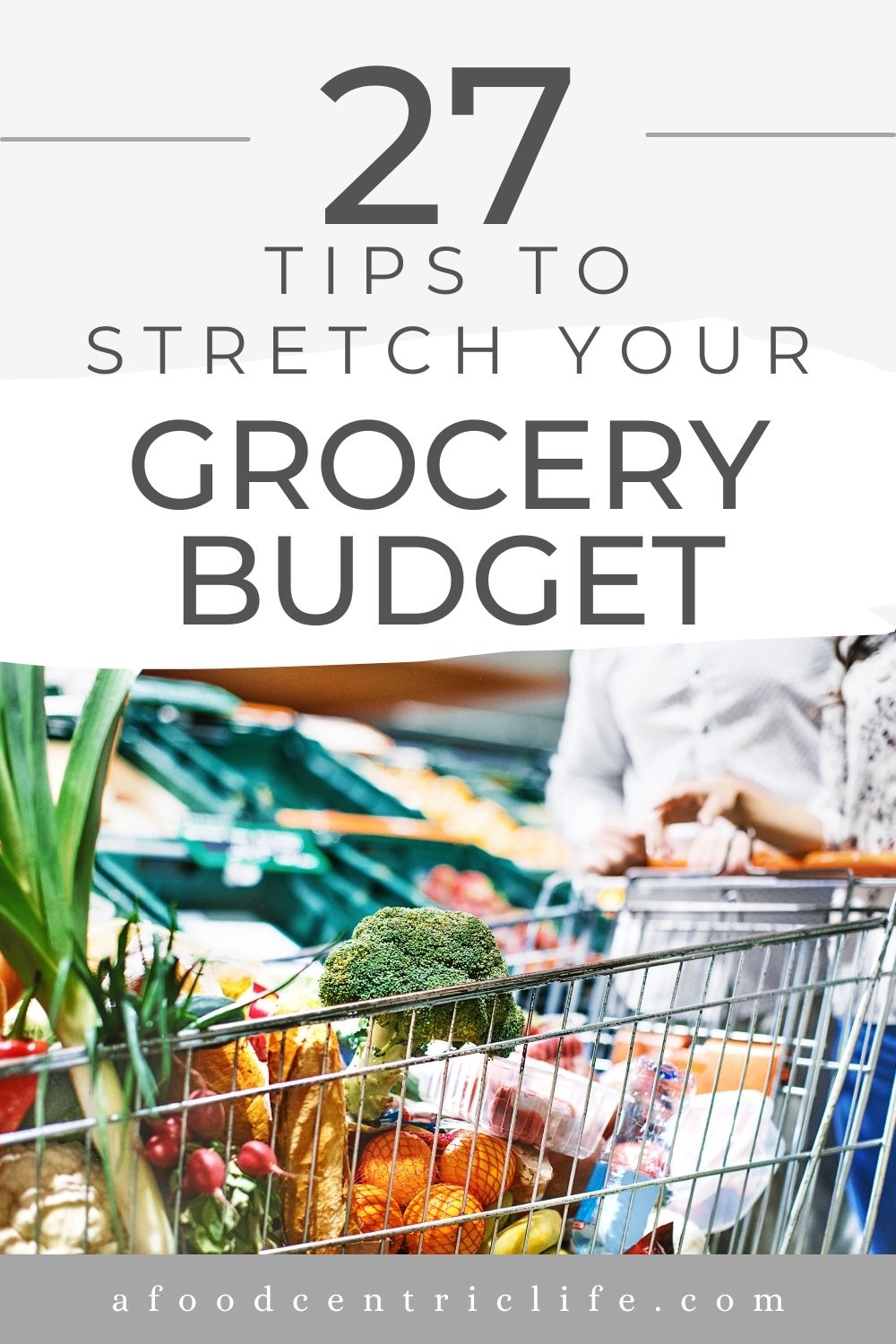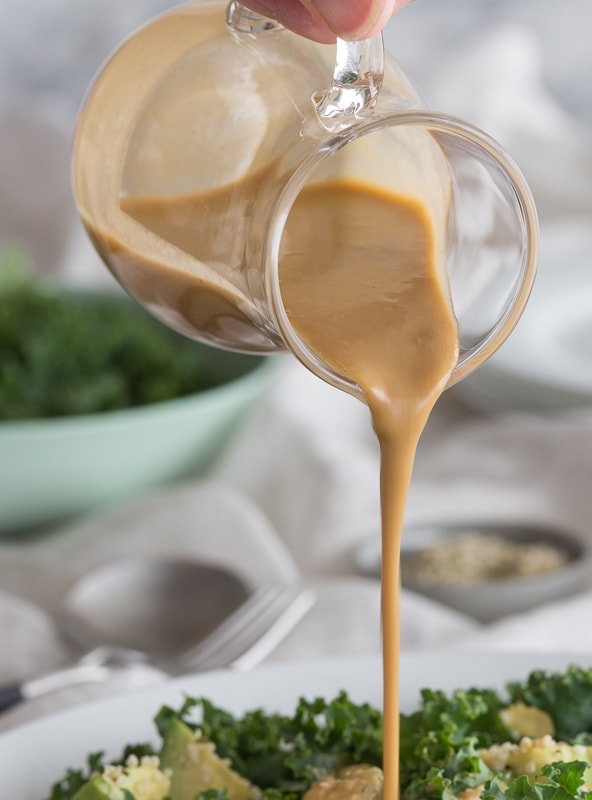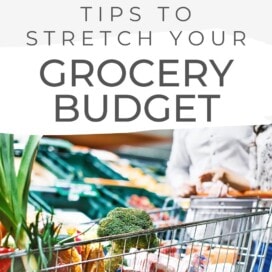We all want to be smart shoppers no matter the budget. When budgets get squeezed, we still want to do the best we can to feed our families healthy. Here are 27 tips for grocery shopping on a budget. Some of the ideas you may have heard before, but hopefully some will be new. Plus I've listed resources and hot links to help you.

1. Shop Seasonally and Save
Produce is cheaper when it is in season. And at the end of a season if you have freezer space, freeze things that are abundant and lower priced, like berries for smoothies. I freeze them on quarter sheet rimmed baking trays, then store in a zip bag. For strawberries, quarter them and for smaller berries like raspberries and blueberries freeze whole. They are nicer than the ones you buy frozen at the store.
2. Shop Farmers Markets
Shop farmers markets for quality fresh produce at a good price. To find a Farmers Market in your area, the National Farmers Market Directory and search by your zip code. Try the Local Harvest site as well.
Here is another resource to check out, the Local Harvest site. The best organic food is what's grown closest to you. Use our website to find farmers’ markets, family farms, and other sources of sustainably grown food in your area, where you can buy produce, grass-fed meats, and many other goodies”.
3. Know When to Buy Organic or Not
Buying organic means less synthetic pesticide residues in our bodies, but organic is more expensive. If your budget is tight, use the EWG’s Guide to Pesticides in produce to make smart choices. Buy organic if the item is on the Dirty Dozen list (if you can). If the item is on the Clean Fifteen list, don’t worry about organic.
And remember the most important thing - eating plenty of fresh, low sugar fruit and vegetables, whether organic or not, is more important than buying organic.
4. Try Community Supported Agriculture (CSA)
Here is the USDA's directory for CSA's. Find out more about how a CSA works and the benefits by reading at this link on Local Harvest.The only catch with a CSA is you might have to be creative as you never know what will arrive in the box.
5. Portion Control
Portion control is not only healthy for your waist but for your budget. For example, 4-6 ounces of protein, like a chicken breast, is a serving. For 4 people, 1 ½ pounds of boneless chicken should be plenty.
When you shop, read the label for the weight. If you shop from a butcher counter, ask them for the weight, not just the number of pieces. And if you do buy or cook extra, save the extra for lunch the next day. Saves time and money.
If you have big appetites at the table (yep, those hungry teenagers playing sports who are really active and growing) you'll probably need a little more.
6. Learn to Love Leftovers
I don't know where or why leftovers became a negative word. It's actually a smart thing to do: cook once and eat twice buy planning for leftovers. Turning leftovers into another meal saves both time and money.
Use leftovers for lunch the next day, or with something like leftover chicken, make a chinese chicken salad or creamy curried chicken salad. It saves you time and money versus buying lunch on the go. Taking leftovers to work from home is cheaper than eating out, and healthier too.
7. Buy a Whole Chicken Instead of Pieces
Buying a whole bird versus pieces is usually a good deal. You pay a premium for parts because someone else did the labor. You can also roast a whole chicken.
I roast a whole chicken once a week and it gives the two of us dinner and lunch. Then I save the body, stripped of most of the meat, and freeze it. To make more freezer space, break the carcass down with a heavy knife or poultry shears and use freezer safe zip bags.
When I get 4-5 in the freezer, I make chicken stock, then freeze the stock for soups and stews. Homemade broth is the best, and making it from roast chicken bones is very thrifty.
One more note on chicken. So many people eat just chicken breast, but chicken thighs are often a little cheaper plus the darker meat is moist and flavorful. Give chicken thighs a try, like this easy teriyaki chicken recipe.

You can also buy a whole bird (watch for the sales) and have the butcher cut it up for you for free. Ask for all of the pieces, the back included, to save and freeze for stock. No butcher to cut it up for you? Learn how to do it yourself.
With a good, sharp heavy knife it is not hard. It just takes a little bravery your first few times until you get the hang of it. You can do this! Here are photos to guide you.
8. Shop the Bulk Aisle
Check out the bulk aisle for better prices on pantry basics. Store bulk items in glass jars in your pantry, labeled with masking tape and a sharpie or stick on labels. Be sure that your store has good turnover on the bulk items so the items are not old. This is especially important with dried beans.
9. Go Meatless, Save Money
Plan a few meatless meals per week. Meat, poultry and seafood (animal proteins) are the most expensive part of a grocery list. Try meatless and save money. You can get plenty of protein with plant-based options. Try this hearty Tuscan white bean soup or this pressure cooker lentil soup.
10. Add Beans to Your Diet
While canned beans are a pantry staple, dried beans and a little time will save you money. Beans are a good source of plant-based protein and fiber. Dried beans become a luscious pot of plump goodness with a few hours of soaking and cooking. A pressure cooker, multi-cooker, or slow cooker make the process easier, but you can do it the old fashioned way with a nice heavy pot.
11. Sticker Smart vs. Sticker Shock
Many markets mark down their fresh meat and poultry as they get nearer to the "sell-by" date. Watch for the special deal stickers and use it that night or freeze it. Talk with the meat department staff to understand when they do this to take advantage of lower prices.
12. Subscribe for the Specials
Subscribe on the market's website for their weekly specials, and the sales information comes right to your email or text. No paper ads to deal with. And as for coupons, use them only if it makes sense and you really need the item. Don't buy it just because its on sale.
13. Share Warehouse Memberships
Warehouse stores may have great prices, but the quantities are usually huge. Find a shopping buddy and share the quantities to get the better price. This is also great if only one of you has a membership. Sharing is a good thing.
14. Use Community Resources to Help Cover
If you have lost a job and need help until you find a new one, check out community resources to help make ends meet. Many churches and community organizations have food pantries open to everyone.
They usually provide canned and nonperishable goods as well as many frozen items and sometimes fresh produce from local farms, all for free to those in need. You might not need all of what they give out, but maybe a few select items could fill in the blanks and help stretch shopping dollars.
To find a food bank in your area try this website.
15. Be Willing To Shop Around
Be willing to shop at a variety of stores to get what you want and save money, but beware you don't spend a lot of extra gas money trying to save grocery money. Stores like Trader Joes are known for their great prices. Another chain called Food4Less has low cost deals on groceries. Find these types of stores in your area and get to know them.
16. Try Lower Cost Cuts of Meat
Ask the butcher about lower costs cuts and how to cook them. Boneless, skinless chicken breasts cost more than bone-in chicken thighs. The thighs have lots of good flavor and are easy to cook in many tasty ways.
Lower cost cuts of beef may not be as tender, but are full of beefy flavor. Slower cooking renders tougher cuts tender and flavorful. Think stews and other long cooking methods, and of course using slow cookers.
It's also hard to beat ground meat. Good prices and many ways to cook, plus it freezes well for when it's on sale. Try making ground beef taco filling.

17. Drink Water Not Sugar
Skip high cost, poor quality liquids like soda (terrible for you in all forms) and juices. Sodas (diet or regular) are just colored, artificial chemical water. Juices are just liquid sugars; not healthy at all. Both are expensive. Drink lots of fresh water. Add slices of citrus or cucumber for a little refreshing flavor. Use the dollars saved for more important groceries, like protein and produce.
And another tip on liquids, make homemade non-dairy milks such as homemade hemp milk (about $3 a quart), homemade almond milk, and fast and easy coconut milk for less that purchasing at the store. Healthier too with no additives.
18. Shop Online and Save
Thrivemarket.com is an online market whose mission is expanding access to healthy living. They sells healthy foods for wholesale and I've saved a lot shopping on this site. It is a membership site ($5 a month, $60 a year), after a trial period, and they offer a nice discount on your first order.
Shipping is free over a low amount. And for each membership, they give a membership to low income families. Great resource. They add new brands and products continually. They have the best price on cashew butter, which I cannot live without, and nut butters can be pricey.
19. Buy From the Growers
One of my basic staples is raw almonds used for snacking and for making almond milk. Try buying in bulk, direct from a grower in California.
Here's my favorite current brand of almonds (direct) or you can buy them on Amazon.
20. Embrace Eggs
Eggs can be enjoyed for any meal, not just breakfast. Eggs are an excellent source of protein and inexpensive for what you get. Poached, scrambled, or turned into omelets, eggs are a good source of low cost, healthy protein. Eggs are versatile and affordable. And to make perfect hard boiled eggs, try my method for easy peel eggs, then turn them into this delicious egg salad or use them as snacks.
21. Plant a Garden
Plant a garden - especially fresh herbs in pots. Great to cook with and lots cheaper than buying them. If you have room, plant vegetables, lettuces, have fun and experiment. There is something incredibly, simplistically satisfying about cutting fresh herbs from your yard and using them in your food. Right now I have thyme, oregano, basil, sage, cilantro, parsley, dill and chives growing. Skip those expensive little packages when possible.
22. Stop Wasting Money at Breakfast
Stop eating expensive, highly processed, sugary cereals that are unhealthy for breakfast. Try rolled or steel cut oats (buy in bulk) or Greek yogurt, make smoothies, or scramble eggs.
And making coffee at home is sure a lot cheaper than that local coffee place with the green mermaid which adds up fast!
Let this Guide to Making Healthy Smoothies help you create healthy recipes for breakfast instead.
23. Analyze Your Spending
Analyze where your grocery money goes. What costs the most? Is it healthy like whole fresh foods and produce or unhealthy stuff like junk food, processed or packaged food? Make smarter, healthier choices, save money, feel better.
Are a lot of chips, cookies, and snack foods in your grocery cart? They are expensive and give you zero nutritional bang for your buck. Focus on whole, fresh foods. Skip junk, processed and many frozen, packaged foods too. They are usually costly and unhealthy.
24. Adventure Into Ethnic Markets
Ethnic markets can transport you around the world. Venture in and explore. Good prices in spices and staples are to be had. You never know what you might learn or find. Around our area there are Asian, Indian, Persian, Vietnamese, and Japanese markets just to name a few!

25. Skip Bottled Dressings
Is your refrigerator door filled with bottled salad dressings? Many are filled wtih unhealthy ingredients, sugar, HFCS, poor quality fats and preservatives. Toss them and make your own with a healthy oil and vinegar.
Opt for extra virgin olive oil as your base and add red wine vinegar, or one of the many flavored vinegars for fun.
The basic ratio is 3 parts oil to 1 part vinegar to start. Adjust for your taste preference. Citrus juice works well too instead of vinegar. Add a little Dijon for flavor and creaminess or a little tahini (sesame seed butter).
Find more salad dressing recipes at this link and vinaigrette recipes here.
26. Don't Buy Bottled Water
Bottled water can be pricey. Buy refillable bottles and and a good filter and refill your own to carry for pennies a day, plus it's better for the environment.
27. Make a List and Follow It
And lastly, make a grocery list and follow it. If its not on the list, skip it. Don't get tempted into buying stuff you don't need or have not planned on how to use wisely. The stores job is to get you to spend money. Don't fall for it. And don't shop hungry!
With all of this cooking at home, you will save money, because going out costs more and is not as healthy.

Faylinn says
I'm always looking for ways to save money on my grocery shopping, and so I really like your idea about skipping the bottled dressings. Next time that I have my grocery shopping done, I will make sure to get virgin olive oil and red wine vinegar. Another thing that I think that would be good would be to replace it all together by using a lemon and squeezing it on top.
Sally Cameron says
Hi Faylinn. Good for you. Toss the bottles and start making your own. You will never go back. Just squeezing lemon juice over the top is awfully tart. And we really do need the healthy fat that a good oil like olive oil adds. Fat is not the enemy. For a basic vinaigrette use the ratio of 3:1 - that is 3 parts fat to 1 part "acid" like vinegar or lemon juice for a lemon vinaigrette. Add a tiny bit of Dijon or Tahini to make it creamy.
Denise says
Thank you for the useful tips. I am trying to get debt free and I am aware of those things. Great resource!